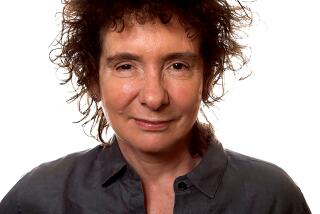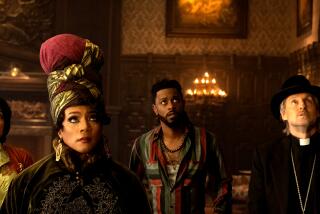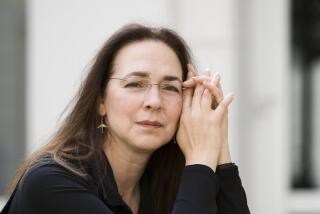Holy Land
- Share via
Golf is a spooky game. Occult forces are clearly at work as we play. Balls vanish in unaccountable directions, glass walls arise in the direction of the hole, putts run uphill. The phenomena recorded in “The Haunted Major” all ring true, especially in relation to the hapless beginner who is our hero: “I let drive a second time, with the result that the ball took a series of trifling hops and skips like a startled hare, and deposited itself in rough ground some 30 yards off, at an angle of 45 degrees from the line I had anxiously hoped to take.” The “anxiously” is an uncharacteristic admission for Major the Honourable John William Wentworth Gore, 1st Royal Light Hussars, a sublimely self-confident snob and self-proclaimedly “the finest sportsman living.” It will take all of golf’s devious powers of humiliation to bring him low, and it is one of this little novel’s achievements that by the end, boastful cad though he is, we are rooting for him.
Published in 1902, before the literature of golf amounted to much--before Arnold Haultain wrote “The Mystery of Golf,” before Bernard Darwin began his decades of inspired journalism, before P. G. Wodehouse launched his incomparable series of comic golf stories, before Bobby Jones elegantly committed his thoughts on the game to print--”The Haunted Major” provides a classic portrait of a hotly contested match, one hard to top in its violent swings of momentum. Haunting, interestingly, remains a theme of modern golf literature, most impressively in the apparition of the mystical teacher Shivas Irons in Michael Murphy’s “Golf in the Kingdom.” And there are lesser texts involving a heavenly replay of the Hogan-Fleck playoff in the 1955 Open, or an extraterrestrial tournament matching up the revenant greats of every era against one another. None of these spooks is as vivid and vehement as the ghost of Cardinal Smeaton, whose Scots curses ring in the dazed Major’s ears while his transparent bones bedevil his eyes. In truth, we all play golf accompanied by a demon, an inner voice who taunts us and advises us and all too rarely floods us with sensations of golfing grace and power, such as the Major feels when he grips the Bishop’s ancient clubs: “My legs and arms tingled as if some strong stimulant were flowing in my veins.”
Cardinal Smeaton never existed, but a close approximation did exist in the person of the first Scotsman to be anointed a cardinal, David Beaton (1494-1546). Beaton, educated at the universities of St. Andrews and Glasgow, and then at Paris and Rouen, was the third son of a Fife laird and the nephew of James Beaton, archbishop of St. Andrews, whom David succeeded as archbishop and primate of Scotland in 1539. Beaton was a considerable politician, of the French-alliance persuasion. As the trusted advisor of James V he dissuaded the monarch from following the anti-papal policy of England’s Henry VIII, and he helped arrange the marriage of James and the daughter of Francis I of France.
These were awkward times, however, in which to be a Scots prince of the old church. Protestantism was spreading on the Continent, and George Wishart, a grammar school master in Montrose, caught the contagion. Accused in Scotland of heresy in 1538, Wishart fled to Europe but returned in 1544, preaching at his peril and converting John Knox, a former priest and ecclesiastical notary who became a spearhead of the Protestant movement. Beaton was a hard-line enemy of the Reformation and saw to Wishart’s arrest, trial, and death by burning in 1646, in St. Andrews. To quote the Blue Guide to Scotland: “Beaton watched the burning in comfort from the castle walls. Two months later several friends of Wishart, headed by Norman Leslie, son of the Earl of Rothes, seized the castle, slew Beaton and hung his corpse over the battlements to prove he was dead.” The conspirators held out for two months, during which Beaton’s body remained unburied, cast into a dungeon and covered with salt, “to await,” as Knox, one of the besieged, explained, “what exsequies his brethren the bishops would prepare for him.” The Encyclopedia Britannica mildly relates that “although John Knox and others have exaggerated his cruelty and immorality, both were harmful to the Roman Catholic Church in Scotland, which he tried to preserve by repression rather than by reform.”
My encyclopedic sources do not mention Beaton’s prowess at golf, but since he had been a university student at St. Andrews, with an uncle established in the cathedral, it is not unlikely he took his whacks at a game already so popular in the 15th century that Parliament three times sought to ban it, on the grounds that it was distracting young men from their archery practice. So the author of “The Haunted Major” may have sound historical reasons for having his ghostly Cardinal claim, “Noo, in ma day, I was unrivalled as a gowfer; there wasna ma equal in the land. Nane o the coortiers free Holyrood were fit tae tee a bat tee me.” Smeaton explains his passionate interest in the Major’s match by telling him that his opponent, the champion Jim Lindsay, is “a descendant in the straight line o’ ane o’ my maist determined foes . . . and ony blow that I can deal tee ane o’ his kith is a solace to ma hameless and disjasket speerit.” It is the Columbia Encyclopedia that throws light on this particular dark spot of Scots history. Its entry for “Sir David Lindsay . . . (c. 1490-c. 1555), Scottish poet” tells us that “As a writer he was a harsh satirist and moralist who directed most of his invective against the Roman Catholic Church. He never formally left the church, but his exposure of its abuses gives him a place second only to that of John Knox in bringing about the Scottish Reformation.” The embers of these fiery old quarrels still give off some heat, and the author, in making Beaton so winning a ghost, offers an olive branch, three and a half centuries after bloody events.
Robert Marshall, the author of “The Haunted Major,” is absent from all but the most compendious reference books. He was born in Edinburgh in 1863, attended the universities at St. Andrews and at Edinburgh, and then joined the Duke of Wellington’s cavalry regiment, attaining the rank of captain in 1895. He retired in 1898 to become a writer and playwright and died in 1910, before reaching the age of 50. That he was a Scotsman might be deduced from the ringing verve of the nearly opaque Scots accent he transcribes, from the intimacy shown with the bitter turns of historic religious struggles on Scots soil and from his satiric creation, in “Jacky” Gore, of so fatuous and arrogant an Englishman. There is a touch of satire, too, in his sketch of the American prize, the rich widow Katherine Clavering Gunter. Her beauty, we are permitted to guess, is ground under some repair: “She is quite beautiful, especially in her photographs”; “I should have thought her face was pale but for two vivid splashes of a most exquisite carmine that glowed, or at all events dwelt, on her cheeks”; “Her wonderful complexion was more ravishing than ever in the soft lamplight . . . and her luxuriant hair, dark underneath, was a mist of everchanging gold on the top.” Nor do the Scots escape, as it were, scot-free: a careful explanation that they are not really dour and stingy leaves us unpersuaded. A national weakness is lightly touched upon by Kirkintulloch when he says it would dishonor his father and mother if he failed to go nightly to the public house, and anyway, “I canna sleep if I’m ower sober.” Not that the Major’s casual consumption of whiskeys and brandies, with a golf match hard upon him, shows any less devotion to fermented spirits.
Americans will be amazed, to the point of doubting the tale’s veracity, when they calculate, as I did, that a round of 18 holes, with one player hitting a wealth of imperfect shots, takes from 11 in the morning to one in the afternoon--a mere two hours--and that the afternoon round, beginning at 2:30, appears, even with its dramatic and drawn-out denouement, to be over in plenty of time to revive the victor from a faint and treat him to several celebrations, a stiff brandy-and-soda and two valedictory interviews, all before he dons dinner dress and goes a-wooing. As the Scots play it, golf is a brisk walk in natural surroundings and not a five-hour ordeal in a hand-carved Oz. As those who have experienced golf in Scotland can attest, religious sensations are not confined to haunted Sunday matches: the skylarks, the breezy breadth of the treeless links, the blowing tan grass, the plunge and rise of the sandy fairways and the accretion of lore attached to courses centuries old all inspire a reverent sense of being, as in the Holy Land, at the source.
I have played St. Andrews--called St. Magnus here--but once, beginning on a Mayday near dinner time and ending in the gloaming between nine and 10 o’clock; my wife walked with me, across the narrow burns and beside the patches of golden gorse, out to the hook-shaped point and then back. One flits to a number of the same enormous greens a second time, at a different pin. I felt tall and ghostly, swinging my thin-bladed rented clubs, as if my feet were treading air. This was golf as a kind of sailing voyage, with the sea a constant presence, the sea from whence once came French ships and the winds of reformation.
In St. Andrews there are three sights to see: the golf course and its solemn Victorian clubhouse; the ruins of the cathedral, by far the largest in Scotland; and the ruins of the castle where Cardinal Beaton watched Wishart burn and was then himself slain and preserved in salt. “The Haunted Major” brings all three together in a curious amalgam of religious history, Edwardian foppery and golfing madness, somewhat as the ruddy color of Kirkintulloch’s mustache “suggested equally sunshine, salt air and whisky.” There must be, we feel, a connection among the three salient features of Scotland: the beautiful wildness of much of its landscape, the austerity of its Presbyterian brand of Protestant Christianity and its national passion for golf. The Major is an alien amid these barbaric elements, and one of the sources of his narrative’s comedy is the mellifluous innocence of his frequently startled prose; he is the prototypical colonizer blundering through the tortuous mysteries of the colonized, and the reader feels the pleasure of order restored when he at last seeks out “the best morning train from St. Magnus to London.”
Harry Furniss’ scratchy, suitably hectic drawings have become as wedded to this text as Gluyas Williams’ illustrations are to Benchley and Tenniel’s to the Alice books. Furniss comes as close to depicting the ineffable as one would wish, and the last two illustrations, of the Cardinal’s headstand on the historic railway shed on St. Andrews’ 17th hole and of his strenuous effort on the 18 to blow a putt awry, linger in the mind’s eye as emblems of the contortions that golf inflicts on its transported devotees.
More to Read
Go beyond the scoreboard
Get the latest on L.A.'s teams in the daily Sports Report newsletter.
You may occasionally receive promotional content from the Los Angeles Times.










